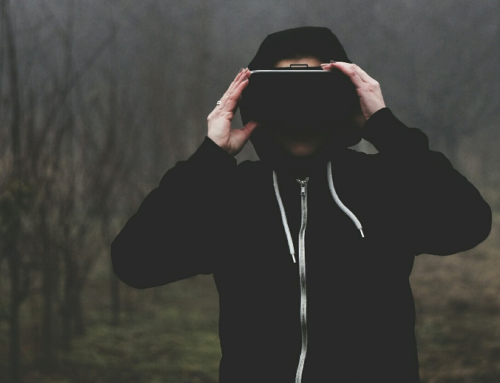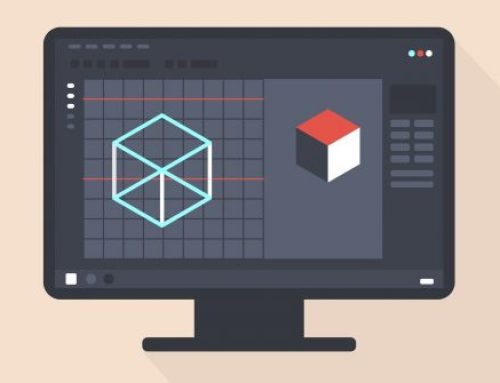Ein kurzer Leitfaden zur VR Motion Tracking Technologie.
Wenn Sie eine virtuelle Umgebung betreten, in der keine Motion-Tracking-Technologie verwendet wurde, wird sich der Besuch nur wenig lohnen. Motion Tracking ist die Digitalisierung von Bewegung, um von Computern verwendet zu werden. Diese Technologie ist von entscheidender Bedeutung für die Schaffung eines hochwertigen Virtual-Reality-(VR-)Erlebnisses.
Ohne Motion Tracking in der VR würden Sie sich in der virtuellen Welt etwas eingeschränkt fühlen und nicht in der Lage sein, sich umzusehen, zu bewegen und zu erforschen. Das beste Szenario wäre, ein Gamepad zu benutzen, um die Bewegung innerhalb der virtuellen Umgebung zu kontrollieren, aber das würde nur dazu dienen, das Gefühl der Immersion zu zerstören.
Die Möglichkeit, in dem Moment, in dem Sie an ihrem VR-Headset ziehen, in die virtuelle Welt einzugreifen und mit ihr zu interagieren, ist entscheidend für die Schaffung eines immersiven Erlebnisses.
In der realen Welt benutzen wir unsere Hände, wir drehen unsere Körper, wir bewegen unsere Köpfe und die virtuelle Welt muss dieser Bewegung nachahmen. Natürlich wird es Zeiten geben, in denen ein VR-Erlebnis eine sesshafte Einbindung erfordert, d.h. einen Flugsimulator, in dem man mit einem Joystick in einem Cockpit sitzt.
Aber es wird Nuancen geben, die ihren Zustand der Immersion bestimmen oder brechen. Die Möglichkeit, sich natürlich umzudrehen und aus dem Fenster zu schauen oder auf das virtuelle Armaturenbrett zu schauen, hält die Illusion am Laufen.
Zu diesem Zweck gibt es bereits eine Reihe verschiedener Methoden und Technologien, um das Beste aus der Erforschung einer virtuellen Umgebung zu machen. Aber wie funktionieren sie? Und wo sollten Sie damit beginnen, das Richtige für ihr spezielles VR-Erlebnis zu wählen.
In dem folgenden Beitrag haben wir ihnen einen kurzen Überblick über die Grundlagen dieser Technologie und die derzeit verfügbaren Optionen erstellt. Aber zuerst…
Was wird durch Motion Tracking getrackt?
Zunächst ist es wichtig zu verstehen, wie sich ein Objekt im dreidimensionalen Raum bewegen kann. Dies lässt sich am besten mit dem Konzept der sechs Freiheitsgrade erklären, das sich auf die Bewegungsfreiheit eines starren Körpers im 3D-Raum bezieht.
Im Wesentlichen kann sich der Körper vorwärts oder rückwärts, aufwärts oder abwärts und von links nach rechts bewegen. Oder anders ausgedrückt, in drei senkrechten Achsen. Dies wird dann mit einer Drehung um diese Achsen kombiniert, die oft als Pitch, Yaw und Roll bezeichnet wird.
Also muss jedes Motion Tracking System, das sein Geld wert ist, in der Lage sein, die Bewegung über all diese verschiedenen Grade hinweg zu messen.
Motion Tracking Technologien.
Es gibt einige Optionen, um das Motion Tracking zu unterstützen und diese werden allgemein als optisches und nicht-optisches Tracking kategorisiert.
Das optische Tracking nutzt Bildsensoren, um die Bewegung des Körpers zu verfolgen. In der Zwischenzeit nutzt das nicht-optische Tracking eine Reihe von Sensoren, die in Hardware installiert oder am Körper angebracht werden können, aber die fortgeschritteneren Optionen können auch Schallwallen oder Magnetfelder verwenden.

Die meisten modernen Trackingsysteme kombinieren optische und nicht-optische Methoden, um die Genauigkeit zu erhöhen und da sich diese Sensoren ständig verbessern, hat es zur Entwicklung kleinerer und genauerer Systeme geführt.
Optisches Motion Tracking für VR.
Die optischen Methoden, die für das Motion Tracking verwendet werden, nutzen typischerweise Kameras, um die Bewegung eines Individuums zu verfolgen. Die Person, die verfolgt wird, muss optische Marker tragen, die an bestimmten Stellen des Körpers angebracht werden. Zusätzlich können diese auf Handsteuerungen oder einem Head Mounted Display (HMD) platziert werden.
Vielleicht kennen Sie dieses Konzept des Motion Tracking, wenn Sie schon einmal einen Film wie „The Lord of Rings: The two Towers“ oder „The Rise of the Planet of the Apes“ gesehen haben, in dem der Schauspieler Andy Serkis einen Anzug mit hochreflektierenden Markern trägt, damit die Kameras seine Bewegungen in Echtzeit verfolgen und tracken können.

Die kommerziellen Systeme, die für das VR-Motion-Tracking genutzt werden, verwenden jedoch nur wenige strategisch platzierte Marker.
Wie funktioniert es?
Wenn alles so eingestellt ist, dass es die Bewegung verfolgt, registrieren die Kameras, die die Tiefe berechnen können, den Marker und ordnen ihn der 3D-Umgebung zu.
Diese reflektierenden Marker werden wegen ihrer Neigung, Licht zu reflektieren, auch „passive Marker“ genannt. Und das bedeutet, dass es eine entsprechende Form des Trackings gibt, die „aktive Marker“ verwendet. Dabei handelt es sich um computergesteuerte LEDs, die dem Anwender eine wesentlich höhere Genauigkeit bei der Verfolgung von Bewegungen ermöglichen.
Aufgrund der Tatsache, dass diese LEDs mit Strom versorgt werden müssen, sind aktive Marker für Consumer-VR-Geräte nicht weit verbreitet. Die meisten HMD auf dem Markt, die Marker für das Motion Tracking verwenden, haben passive Marker.
Und doch ist einer der bemerkenswertesten Ausnahmen der Sony PlayStation Move Motion Controller. Es verwendet ein großes Licht, dem die Konsole über eine Kamera folgt. Obwohl es nicht ganz so fortschrittlich ist, die aktiven Marker der Filmstudios, die uns Gollum und Caesar gegeben haben, werden die Controller der PlayStation weiterhin von nicht-optischen Sensoren unterstützt, um ihre Genauigkeit zu verbessern.
Andere bemerkenswerte Beispiele.
Das beliebteste und wohl auch das erfolgreichste Consumer Motion Capture-Gerät ist zweifellos Kinect von Microsoft. In Verbindung mit der Xbox und Windows-Computern ist der Kinect in der Lage, unglaublich komplexe Bewegungen zu verfolgen, ohne aktive oder passive Marker zu verwenden.

Seine Kamera muss nur die Person sehen können, die davor steht. Und die allerneueste Version kann bis zu sechs Personen gleichzeitig tracken. Trotz des Einsatzes einiger sehr innovativer Software und Grenztiefen- und Infrarotkameras ist es jedoch noch nicht in der Lage, die genaue Beschaffenheit der markerbasierten Trackingplattformen abzubilden.
Ein weiteres Beispiel für ein Tracking-System, das nicht auf Markern basiert, ist Leap Motion. Wenn es an ein HMD angeschlossen ist, kann dieses Gerät die Handbewegung des Benutzers tracken, was eine natürliche Möglichkeit der Interaktion innerhalb einer virtuellen Umgebung ermöglicht.
Der nächste Schritt zum optischen Tracking.
Der nächste logische Schritt für kommerzielle VR-Systeme wird das Tracken des gesamten Körpers sein. Jedoch sind Systeme, die mit den professionellen (und teuren) Systemen konkurrieren, wahrscheinlich heute noch ziemlich weit davon entfernt.
Die meiste VR-Hardware ist so konzipiert, dass sie sicher im Sitzen genutzt werden kann. Unüberwacht herumzulaufen, während man ein VR-HMD trägt, kann Verletzungen nach sich ziehen.
Dennoch hat das talentierte Team von SteamVR etwas entwickelt, das dieses Szenario verändern könnte. Es heißt Lighthouse Tracking System und ist ein laserbasiertes Tracking-Gerät, das passive Marker, die an den SteamVR-Controllern und HMDs angebracht sind, lokalisieren kann. Es bildet dann die Objekte im Raum ab und bietet einige wichtige Sicherheitsmaßnahmen, um zu verhindern, dass Sie sich selbst verletzen, wenn Sie sich in der virtuellen Umgebung bewegen.
Nicht-optisches Motion Tracking für die VR.
Das ist Ihnen vielleicht nicht bewusst, aber die derzeit verfügbaren VR-Geräte enthalten wahrscheinlich alle kleine elektromechanische Sensoren. Dies sind typischerweise Gyroskope, Magnetometer und Beschleunigungssensoren, die unter die Kategorie des nicht-optischen Trackings fallen.
Mikroskopisch klein, werden diese Sensoren zur Messung und zum Tracking bestimmter Bewegungen eingesetzt. Beispielsweise misst der Beschleunigungssensor die Bewegung entlang der dreidimensionalen XYZ-Achse, während der Gyroskop die Drehung um 360 Grad misst. Und das Magnetometer kann die Richtung eines Magnetfeldes messen, d.h. es kann z.B. bestimmen, in welche Richtung der magnetische Norden verläuft.
Diese Sensoren sind jetzt unglaublich günstig, klein und genau, dank der technologischen Fortschritte in der Automobil-, Luftfahrt- und Computer-Hardware-Industrie. Sie sind heute eine tragende Säule in allen modernen Smartphone- und Tablet-Geräten und VR-Headsets sind dem Beispiel gefolgt.
Wie funktioniert es?
In Kombination liefern diese drei kleinen Sensoren unglaublich präzise Bewegungsdaten mit sehr geringer Latenz. Ergänzt durch optische Trackingmethoden, einschließlich der aktiven oder passiven Marker oder Infrarotkameras, bieten diese nicht-optischen Tracking-Geräte eine robuste und abgerundete Motion-Tracking-Lösung.
Aber wenn es um ein in sich geschlossenes System geht, sind diese Sensoren mehr als in der Lage, sich zu behaupten. Man braucht sich nur die schiere Zahl der heute verfügbaren Virtual Reality-Smartphone-Apps und -Headsets anzusehen, um diese Behauptung zu belegen.
Andere bemerkenswerte Beispiele.
Die alternativen nicht-optischen Methoden in der Praxis erinnern stark an Science-Fiction – aber sie sind wissenschaftlich sehr fundiert.
Nehmen wir zum Beispiel das direkte elektromechanische Tracking der Körperbewegung. In einem VR-Kontext könnte dies durch einen haptischen Handschuh erreicht werden, der beim Beugen der Finger die Bewegung in Signale für das Tracking umwandelt.
Eine weitere Methode ist der Einsatz eines Exoskeletts, das neben der Bewegungserfassung auch haptisches Feedback liefern kann. Nun, diese sind weit davon entfernt, kommerziell erhältlich zu sein, aber die Fortschritte, die Unternehmen wie Dexmo machen, sind ermutigend.
Schließlich ist das Laufband Virtuix Omni ein weiteres Beispiel für einen mechanischen Motion Tracker. Es erlaubt dem Benutzer nicht nur, in alle Richtungen innerhalb der virtuellen Umgebung zu laufen, sondern es verfolgt und misst auch die Bewegung, wenn auch etwas grob im Vergleich zu den anderen bereits erwähnten Methoden.
Was wird die Zukunft bringen?
Es ist klar, dass es eine Reihe von existierenden und potenziellen Technologien gibt, die einen weitreichenden Einfluss auf die VR-Industrie haben werden.
Und es ist sicher, dass sowohl die nicht-optischen als auch die optischen Tracking-Methoden in diesen Motion-Tracking-Plattformen für einige Zeit zum Einsatz kommen werden. Aber das ultimative Ziel der VR-Technologie ist sicherlich, den Benutzer in eine völlig virtuelle Umgebung zu transportieren und einzutauchen, in der er seine Gliedmaßen und seinen Kopf überhaupt nicht bewegen muss, um die virtuelle Umgebung zu erforschen.
Da die Sensoren weiter verbessert werden und die Elektronik immer kleiner wird – ganz zu schweigen von der Arbeit auf dem Gebiet der Nanotechnologie – ist die Vorstellung, dass man bald ein Matrix-ähnliche Immersion erleben könnte, nicht allzu weit hergeholt.
Vorerst müssen Sie jedoch die Motion-Capture-Technologie nutzen, wenn Sie das Beste aus den heutigen VR-Systemen machen wollen.
Wie kann Appeal-VR helfen?
Mit den Fortschritten im Motion-Tracking und den nicht-optischen Tracking-Systemen, die in modernen Smartphones vorhanden sind, besteht die Möglichkeit, durch die Entwicklung einer hochmodernen VR-Anwendung wirklich Wellen in Ihrer Branche zu schlagen.
Dank unserer unübertroffenen Erfahrung in der Entwicklung kundenspezifischer VR-Apps über verschiedene Branchen hinweg, können wir Ihr innovatives App-Konzept durch die wichtigsten Design- und Entwicklungsphasen führen. Wir erstellen dann eine effektive Anwendung, die Ihr Unternehmen verändert und Ihre Branche aufhorchen lässt.
Also, sind Sie bereit, den ersten Schritt zur Verwirklichung Ihrer VR-App-Idee zu machen? Dann sprechen Sie uns an.
Bevor Sie die App herunterladen, müssen Sie möglicherweise ihr Smartphone auf die neueste Version von Android 7.1 Nougat aktualisieren.


